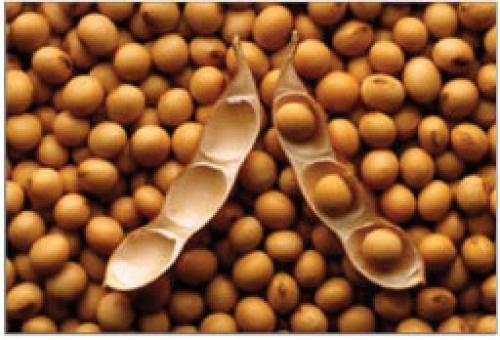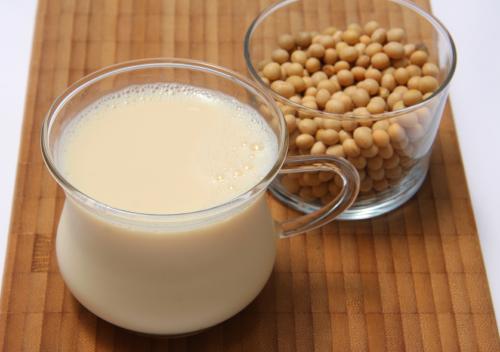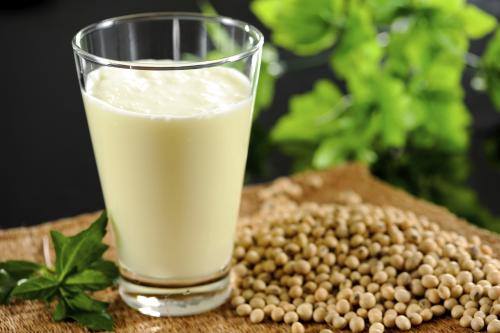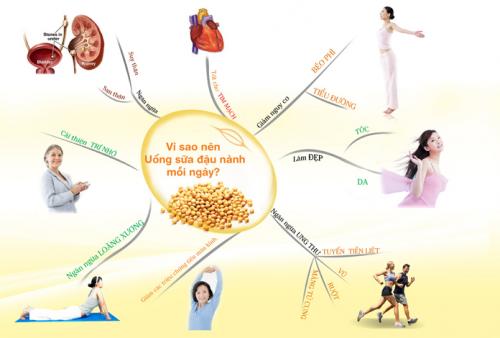
The nutritional properties of soybeans
Soybeans contain 8% water, 5% inorganic matter, 15-25% glucose, 15-20% fat, 35-45% protein and several essential amino acids (soleucin, lysin, metionin, pheny lalanin, tryptophan, valin) along with many vitamins, minerals (Ca, Fe, Mg, P, K, Na, S, vitamins A, B1, B2, D, E, F), enzymes, waxes, oils and cellulose fibers.
In recognition of such high protein levels, soybeans are often referred to as ‘boneless meat’ in many Asian countries. As such, they are an excellent low-fat and low-cholesterol replacement for animal meats. Soybeans have more protein per serving than animal meats, more calcium than cows’ milk, and more lecithin then eggs. Several amino acids which the body cannot produce on its own are found in soybeans.
The nutritional properties of soymilk share much in common with those of cows’ milk. The per serving amount of protein in soymilk is almost equivalent to that in cows’ milk, although with less calcium. Soybeans have the advantage of being lactose-free, and soymilk can serve as a replacement for cows’ milk for those that suffer from lactose intolerance. Soymilk also contains less saturated fats than cows’ milk, and as such has benefits for cardiovascular health.
While any food source’s true nutritional value can perhaps best be ascertained by observing how that source has been favored by human populations over time, the scientific community is nevertheless continuing to research soymilk’s particular properties and advantages in the laboratory.
The ratio of protits and lipits found in soybeans is far greater than in animal meats, especially for proteins. Many people find animal proteins hard to digest, leaving behind harmful residues, causing degradation, and fueling chronic diseases. Soy proteins on the other hand are highly beneficial to health, free from disease causing residues and able to combine with proteins from grain sources to, under certain conditions, mimic the effects of proteins found in animal meats, eggs, fish and other sources. In this way, soy protein can be seen as a replacement for animal protein without the disadvantages, and with added abilities to combine with other proteins and assist in the delivery of nutrients to various parts of the body.
In addition, fat are very low in saturated fat and can be easily absorbed into the bloodstream, acting in defense against obesity and cholesterol. (Oils are 60% unsaturated and only 15% saturated). They also contain linolenic and linolic acids, two acids with positive effects on circulation and cancer fighting properties. Soy fiber has the effect of flushing out the digestive tract and preventing stomach, intestinal and bowel cancers.
Several other compounds found in soybeans have medicinal properties, leading the scientific community to undertake careful research and declare benefits regarding cardiovascular health, muscle readiness, weight loss, and the general maintenance of a slim and healthy body.
Finally, soybeans are rich in vitamins A, E, K, as well as in potassium, iron, zinc and phosphorus, helping the body meet its nutritional needs.

Soymilk information and usage guide
Soymilk contains vitamins A, B1, B2, D, PP, K, F and various healthy enzyms to aid with digestion. In addition, soymilk contains isoflavones, which can make up for lowering estrogen levels in aging women and have positive effects for bone structure,
Do not mix or consume soymilk with chicken eggs; the albumin in egg whites can combine with the tripxin in soymilk to form a compound that is known to cause indigestion and prevent nutrient intake.
- Do not allow soymilk to simmer in a pot or thermos; this may result in an unhealthy transformation of certain organic properties.
- Soymilk is safe for children from 1-5 years old as a partial replacement for animal milk, but should not be considered as a full replacement.
- Homemade soymilk should be boiled diligently to 100C degree before drinking.

Soybeans, isoflavones, and a balanced healthy figure
According to research undertaken by the Vietnam Institute of Nutrition in 2005 covering 7600 families in all 64 provinces, the number of overweight and obese people is rising quickly. The survey found that 16.8% of adult was overweight, rising to 30.1% in women of child-bearing age.
Why are women overweight?
Being overweight is the result of an overabundance of fat in the body and is considered a threat to overall health. Weight gain occurs when energy intake is not matched with energy burn and extra calories are stored in layers under the skin. Diets most commonly associated with being overweight are marked with high calorie counts, high fat levels and large amounts of sugar; these in turn are contrasted with little exercise. Changes in the female hormone beginning around age 40 can also lead to weight gain.
Hormone imbalances during the onset of menopause, especially regarding estrogen, can lead to weight gain in certain areas. Known as the female hormone, estrogen is used to regulate certain processes in the female reproductive system, including the ovaries. It can also stimulate the storing of fat in the thighs and buttocks (also known as gynoid fat or having a ‘pear shaped’ figure) as a means of keeping fat away from the belly area. The effects of estrogen are strongest during teenage years, and well as the years surrounding childbirth. As age increases, the effects of estrogen slow. When women reach menopause, the amount of estrogen produced by the body decreases significantly, making it easier for fat to collect around the stomach and midsection. It is during this time that many women become overweight.
Treating the problem with weight loss drugs or hormone replacement therapy can have negative effects for health. The US Women’s Health Initiative and the National Institute of Health conducted a study of 16,000 women who had tried such methods and found there to be an increased risk of heart disease, stroke, high blood pressure and breast cancer.
Isoflavones found in soy: a better choice for a healthy figure.
Soy-based foods and drinks not only represent good nutritional value but also supply the body with certain compounds that have seemingly magical properties. Of the phytochemical group, isoflavones have elicited the most attention. Isoflavones are often called ‘estrogen from plant’ because they possess a chemical structure similar to that of estrogen produced in the body. As such, they can help the body maintain an ideal weight and are beneficial to health. Recent studies have shown a diet rich in soy proteins and isoflavones can offset lowering estrogen hormone.
A study published in July 2003 in the Journal of the North American Menopause Society undertaken by researchers at the University of Iowa showed isoflavones had a noticeably positive effect in the maintenance of a healthy figure. Taking part in the study were 69 women entering menopause. They were divided into three groups, with the test groups administered 40 g of soy protein rich in isoflavones for 24 weeks. Results showed women in the test groups were able to maintain healthier figures than those in the control group, highlighting the effect of isoflavones regarding keeping fat away from the stomach.
Isoflavones naturally derived from soybeans are therefore an excellent choice when it comes to maintaining a healthy weight and balanced figure, with fat distributed more attractively around the body, including in the thighs and buttocks. This also avoids risks from the use of weight loss drugs and hormone replacement therapy. Isoflavones are a natural solution for those seeking an attractive figure and good health.
Dr. Thi Ngoc Diep
Director, Ho Chi Minh City Centre for Nutrition

Healing properties of soy
Better cardiovascular health
Heightened cholesterol levels can lead to arteriosclerosis, high blood pressure, heart blockages, stroke… Naturally occurring compounds found in soybeans, including isoflavones, genistein, daizein and glycetein, help reduce the negative effects of cholesterol and regulate levels over the long-term.
-The US FDA recommends 25 g of soy protein as part of daily intake to maintain good cardiovascular health.
-In countries where soy-based food and drink products are enjoyed regularly, rates of heart disease are low.
Reduced risk of obesity
Soy-based food and drink products are naturally low in starches, rich in protein and a source of several amino acids. Also low in cholesterol and saturated fats, these products are very effective at regulating fat intake, reducing body fat stored around the waist and bringing hunger levels down.
Reduced risk of diabetes
People with diabetes suffer from high blood sugar. The reason for this is absent insulin or reduced insulin function preventing sugar from being sent to the liver or stored in fat cells. Soy-based food and drink products are very low in sugar and high in natural fiber, making them a safe addition to a blood-sugar conscious diet.
More vibrant skin and hair
Soybeans contain the organic compound BBIC, which inhibits the function of protease, an enzyme that can lead to skin diseases such as sclerosis. The frequent enjoyment of soy based products can help to:
-Reduce the visible signs of aging and give the skin a radiant and tighter look.
-Encourage the growth of stronger, healthier hair.
Reduce the effects of osteoporosis
Soy-based food and drink products are not rich in calcium but are a good source of isoflavones, antioxidant compounds which can prevent bone degradation and assist with the delivery of calcium to bones.
Cancer prevention
Soy-based food and drink products are known to have the following cancer fighting properties:
-The presence of genistein has the effect of preventing damaged cells, reducing the risk of cancer.
-The Bowman-Birk protease inhibitor found in soy protein can in some instances fight the spread of cancer.
-The compound daizein found in soy protein can, when taken in large doses, stimulate the immune system, screen out dangerous elements, and reduce the overall risk of cancer.
The large amount of fiber in soybeans can prevent cancers of the stomach and digestive tract.
Reduce discomfort associated with the onset of menopause
Many discomforts associated with menopause are the direct result of falling estrogen levels. The natural isoflavones found in soybeans have a similar effect to estrogen and can reduce many of the discomforts associated with the onset of menopause. The regular consumption of soy-based foods and drinks is therefore a safe and easy way to reduce these discomforts, and often the method of choice.

